
20
Sescoa Super Speed Format
The Sescoa Super Speed Format must be programmed
exactly as follows to function correctly.
1. The account code must be four decimal digits in length
and in the range of 0001 to 3374.
2. The reporting codes must be 2 digits in length and
programmed as follows.
Alarms Zones 1- 8 (section [05])
A1 to A8
Alarms Zones 9 -16 (section [06])
A9, 1A, 11 to
16
Restorals
Zones 1- 8 (section [07])
A1 to A8
Restorals Zones 9 -16 (section [08])
A9, 1A, 11 to
16
All Opening Codes (sections [13] and [14]) BA
All Closing Codes (sections [11] and [12]) CA
Partial Closing (section [15])
C1
Low Battery (section [09])
E1
Battery Restorals (section [10])
E1
AC Failure (section [09])
E1
AC Restoral (section [10])
E1
Bell CCT. Trouble (section [09])
F1
Bell CCT. Restoral (section [10])
F1
Troubles (sections [09] and [10])
AA
Misc Alarms (section [15])
(A1 to 99)
Test Code (section [15])
1C or DC
System Test Code (section [54])
CC
After Alarm Code (section [50])
B1
Auto-arm Abort Code (section [53])
C8
TLM Restoral Code (section [45])
EE
[28] Programmable Input and Output
Options
Both the Auxiliary Input Zone and the Programmable Output
have options which are programmed in this section. After
the section number [28] is entered, enter 2 HEX digits from
the following lists.
1st Digit Auxiliary Input Zone
[0] Printer attached to panel (see Note 1)
[1] Silent 24 hour input
[2] Audible 24 hour input
[3] Momentary arming input
See Auxiliary Input Terminal in the “Terminal Connections”
section on page 4 for details on the Auxiliary Input. When
option [3] is selected, a momentary key closure between the
Auxiliary Input and the Positive Auxiliary Power Supply will
alternately arm and disarm the system. The reporting codes
for the Auxiliary Input (sections [9] and [10]) can be used as
opening and closing codes for key arming but will only be
transmitted with side A openings and closings.
2nd Digit Programmable Output
See programmable Output Terminal in the “Terminal
Connections” section on page 4 for details on connecting
the “PGM OUT” terminal.
[1] Ground Start Pulse
provides a 2 second ground start
pulse before dialing begins to obtain the dial tone on
ground start telephone equipment.
[2] Utility output ([Q] [7]) no access code
[3] Utility output ([Q] [7]) any access code
[4] Utility output ([Q] [7]) Group A access code
[5] Utility output ([Q] [7]) Group B access code
These options change the “PGM OUT” terminal to different
options used with the keypad utility output [
Q
] [7]
command. See Utility Output Command in the “Keypad
Command” section.
[6] Keypad Buzzer Follow Mode
With this option the
“PGM OUT” terminal switches to ground as long as the
keypad buzzer is on.
[7] System Status (Arm/Disarm) Output
With this option
the “PGM OUT” terminal switches to ground when the
panel is armed. The switch is open when the panel is
disarmed.
[8] Strobe Output (Latched Alarm Output)
With this
option the “PGM OUT” terminal switches to ground after
an alarm and remains switched on until the system is
disarmed.
[9] Failure to Communicate Output
With this option the
“PGM OUT” terminal switches to ground if the system
fails to communicate with the monitoring station after 8
attempts. The output stays switched to ground until a
successful communication takes place or until trouble
#5 is cleared from the keypad. This option may be used
to tie two systems together. One system can then be
made to report a communication failure for the other.
[A] TLM and Alarm
With this option the “PGM OUT”
terminal switches to ground if the system has a TLM
fault and any alarm condition while fully armed. The
output follows the length of ‘bell time out’.
[B] Courtesy Pulse
With this option the “PGM OUT”
terminal switches to ground during the course of the
entry and exit times. It could be used to turn on a light
near the exit for the duration of the entry/exit times.
[C] Printer Attached to Panel
(see Note 1) With this option
a serial printer must be used. See “Printer Setup”.
[D] 2nd Line Slave
With this option the “PGM OUT”
terminal switches to ground after four unsuccessful
attempts have been made to the phone number being
dialed. The output will stay switched until the panel has
hung-up. This could be used to switch the panel to a
backup set of phone lines.
[E] Kissoff Output
With this option the “PGM OUT”
terminal switches to ground after the kissoff has been
received to complete a “successful” communication to
the central station. The terminal switches to ground for 2
seconds.
[F] Remote Operation
With this option the “PGM OUT”
terminal can be switched remotely using the DLS-1
software (version 4.0 or later).
Note (1): If a printer is attached to the panel, both [0]
for the 1st digit and [C] for the 2nd digit must be
entered.
Summary of Contents for PC3OOO
Page 1: ...INSTALLATION MANUAL PC3OOO Version 7 51...
Page 40: ...HOOKUP DIAGRAMS 36...
Page 44: ...29000543 R7...
















































